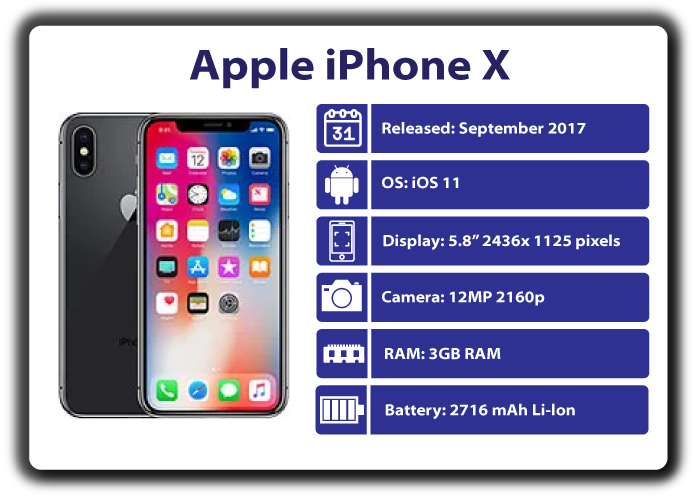The iPhone X, pronounced as “iPhone Ten,” represents a paradigm shift in Apple’s smartphone design and technology. Unveiled on September 12, 2017, the iPhone X marked the 10th anniversary of the iPhone lineup. With its stunning edge-to-edge Super Retina display, Face ID facial recognition, and a host of innovative features, the iPhone X aimed to redefine the premium smartphone experience.
Released: The iPhone X hit the market on November 3, 2017, following months of anticipation and speculation. As a special edition commemorating the 10th anniversary of the iPhone, the iPhone X garnered immense attention for its departure from the traditional design, introducing a bezel-less display and eschewing the physical home button in favor of intuitive gesture-based navigation.
iOS and Last Update: At launch, the iPhone X came pre-installed with iOS 11, Apple’s eleventh iteration of its mobile operating system. Throughout its lifecycle, the iPhone X received consistent software updates, benefitting from the latest features, security patches, and performance enhancements. As of my last knowledge update in January 2022, the iPhone X was still supported by the latest iOS versions available, underscoring Apple’s commitment to providing ongoing software support for its devices.
Display: The centerpiece of the iPhone X is its 5.8-inch Super Retina display, an OLED panel with a resolution of 2436 x 1125 pixels. The edge-to-edge design meant that the display stretched from corner to corner, creating a visually immersive experience. With support for High Dynamic Range (HDR) content and a contrast ratio of 1,000,000:1, the Super Retina display delivered vibrant colors, deep blacks, and true-to-life visuals. The absence of bezels and the introduction of True Tone technology, adapting the display’s color temperature to ambient lighting, further enhanced the overall viewing experience.
Camera: The iPhone X boasted a dual-camera system on the rear, consisting of a 12-megapixel wide-angle lens and a 12-megapixel telephoto lens. Both lenses featured optical image stabilization, ensuring stable and clear photos and videos. The dual cameras supported 2x optical zoom and up to 10x digital zoom. The device introduced Portrait Mode, now enhanced with Portrait Lighting, allowing users to capture studio-quality portraits with various lighting effects. The front-facing TrueDepth camera, also 12 megapixels, enabled Face ID facial recognition, revolutionizing device security. This advanced facial recognition technology replaced the traditional Touch ID fingerprint sensor, providing a secure and seamless authentication experience.
RAM: The iPhone X was equipped with 3GB of RAM, facilitating smooth multitasking and efficient performance. Paired with Apple’s custom-designed A11 Bionic chip, which featured a six-core CPU and a dedicated neural engine, the device delivered outstanding processing power. The neural engine, in particular, paved the way for machine learning and artificial intelligence applications, contributing to the iPhone X’s ability to adapt to user preferences over time.
Battery: The iPhone X housed a non-removable 2716mAh lithium-ion battery, designed to support the device’s advanced features and high-resolution display. The efficiency gains from the A11 Bionic chip, coupled with iOS optimizations, contributed to impressive battery life. The iPhone X supported fast charging, allowing users to charge up to 50% in just 30 minutes, and wireless charging, making it compatible with Qi-enabled charging pads. These features provided users with flexibility in managing their device’s battery life.
Price (USD): Upon its release, the iPhone X was positioned as a premium device with a corresponding price tag. The 64GB model was priced at approximately $999, while the 256GB model came with a higher price point. Over time, as newer iPhone models were introduced, the iPhone X’s price saw reductions, making it more accessible to a broader audience while still retaining its status as a high-end flagship device.
In summary, the iPhone X represented a milestone in Apple’s smartphone evolution, introducing a host of groundbreaking features and design elements. Its edge-to-edge display, facial recognition technology, and powerful camera system signaled a new era for the iPhone lineup, setting the stage for subsequent innovations in the years to come. The iPhone X remains a testament to Apple’s commitment to pushing the boundaries of what is possible in mobile technology.



1 Comment
Thank You for View